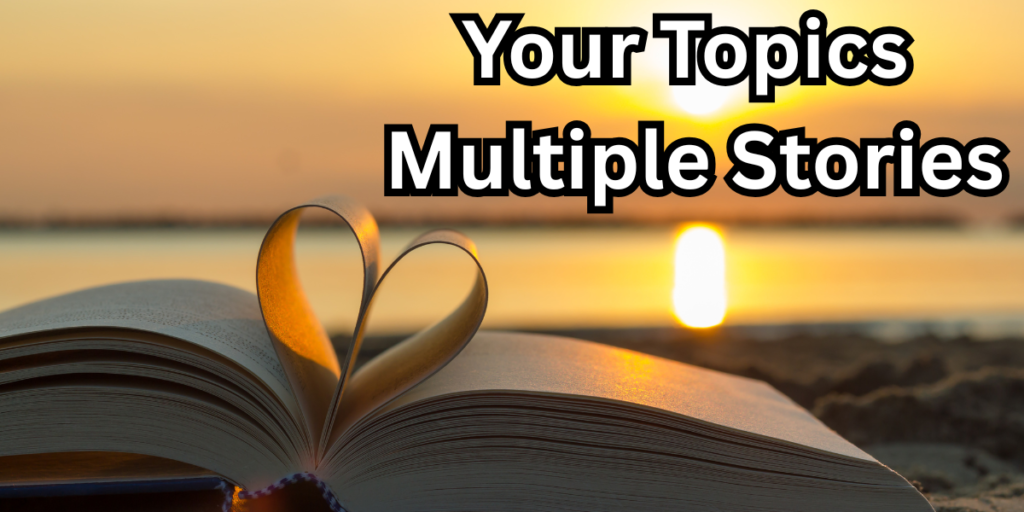Storytelling is essential to communicate effectively. Often times, a single story does not offer enough variation for the audience to engage the various interests of the audience. That is why your topics | multiple stories can be a usage strategy, a flexible, multi-layer approach, that can develop multi-layered content based on your available sub-topics or stories. Regardless if you are embedding your topics | multiple stories as a teacher, presenter, or marketer, your content can gain substantial gains in audience engagement and information retention.
One Topic, One Story — Limited Value
Most content creators, educators, or marketers cannot keep their audience(s) engaged with just one story. In a linear communication method, the different aspects of the intended area of communication can become boring and limit impact.
Common Challenges:
- Audiences disengaging
- Lack of diversity in the content
- Failure to appeal to various learning or consumption styles
- Failure to contextualize various complex or layered topics
Each of these problems can significantly impact the value of your content; particularly in a moving and dynamic environment, or when using the content in classrooms, virtual classrooms, widenar’s or marketing campaigns.
Read Also: Gujarat Titans vs Mumbai Indians Timeline / Mumbai Indians vs Lucknow Super Giants Timeline
Why It Matters More Than Ever
In the digital age, attention spans are shrinking. Relying on a single story to explain a multifaceted topic can be a recipe for lost engagement and missed opportunities.
Imagine presenting to a diverse audience with varied interests. If your message doesn’t resonate with all sections, the core essence of your topic may be lost. This becomes even more critical when you’re addressing complex issues like social justice, climate change, or consumer behavior.
Statistics that Support the Need:
| Insight | Data Source | Findings |
| Attention span in digital users | Microsoft Study | Decreased to 8 seconds on average |
| Learning retention | Harvard Ed. Review | 65% higher in multi-modal storytelling |
| Engagement in multi-topic content | Content Marketing Institute | 72% audience preference |
The numbers speak for themselves. It’s no longer a luxury to use your topics | multiple stories; it’s a necessity.
Embrace Your Topics | Multiple Stories
The approach is to use a storytelling framework with room for multiple sub-plots, perspectives, and voices. With your topics | multiple stories you can explore a broad thematic space with all of that richness that characterizes high engagement.
What is it, your topics | multiple stories?
At its heart, your topics | multiple stories is an approach for interpreting a central topic by exploring it through several narratives. Each narrative brings another facet to the topic, thus permitting a more meaningful consideration of the topic itself.
Examples of applications:
- Education: Teaching climate change through accounts of glaciers melting, communities impacted by rising sea levels, or individual or cultural community shifts effort could be transformative.
- Marketing: Selling your product by incorporating customer success stories, behind-the-scenes production, as well as your specific contributions to social and environmental impact.
- Business pitches: Describing your value proposition through stakeholder views- investors, customers, as well as employees.
Your Topics | Multiple Stories PPT: A Game-Changer for Presenters
Using a Your Topics | Multiple Stories PPT structure can transform your presentations into compelling, memorable experiences.
How to Structure a Multiple Stories PPT:
| Slide Section | Content Type | Purpose |
| Slide 1 | Title + Introduction | Define your main theme |
| Slide 2–4 | Story 1, 2, 3 | Present sub-narratives |
| Slide 5 | Analysis | Draw connections |
| Slide 6 | Conclusion | Wrap up with key takeaways |
By combining visuals, narratives, and data points, the audience remains connected throughout the presentation.
Read Also: Pakistan National Cricket Team vs India National Cricket Team Timeline
Your Themes | A Few Story Examples
Here are some practical examples to provide you with additional inspiration for your storytelling work:
1. Social Justice campaigns
- Story 1: a child’s experience in education
- Story 2: a teacher’s struggle for funding equity
- Story 3: a policy-maker’s challenge to affect change
2. Product Launch campaigns
- Story 1: behind the scenes of product development
- Story 2: stories from early adopters
- Story 3: a company’s vision for its next frontier
3. Environmental Awareness
- Story 1: a community saving a river.
- Story 2: the implications of climate change on wildlife
- Story 3: a school project that became an international project
All of the stories focus on the same theme/topic and contribute to an even greater emotional and intellectual attachment.
Advantages to Using Your Topics | Multiple Stories
✨ Higher Engagement
Multiple perspectives lead to wider engagement.
🤔 Better Understanding
When you give a variety of different stories to communicate a tactically complex topic, it is more relatable and easier to understand.
📣 Stronger Messaging
You can use emotional, logical, and ethical appeals—all using the same piece of work!
Ideas for Crafting Good Multiple Stories Content
Be clear on what your core topic is.
- Outline the subtopics/stories that relate to the core topic.
- Maintain constant voice, tone, and style.
- Utilize visuals, data, and quotes to support the stories.
- Make sure that each story can stand on its own but connected to the other stories.
Application of Your Topics | Multiple Stories by Industry
| Industry | Using Your Topics | Multiple Stories |
|---|---|---|
| Education | Multi-topic lecture that leverages real-life stories | |
| Marketing | Campaign on multiple buyer personas | |
| Corporate Training | Case studies from multiple areas on an issue | |
| Journalism | Covering topic with multiple voices from the community | |
| Healthcare | Telling the story of patients, doctors, and policy as part of the same collection | |
| How to Create Your Topics | Multiple Stories Power Point Step by Step | |
| Identify a primary theme (ex. Sustainability) |
Identify 3-5 related stories
Create a storyboard or outline to identify related or overlapping messages
Create the slides, the more visuals and the less text the better
Use additional slides as transitions between stories (to separate the content)
Finish with a unified message
Potential mistakes to consider
- Too many unrelated stories
- Lack of connection
- Drowning each slide with content
- Forgetting to share the content
FAQs About Your Topics | Multiple Stories
Q1. What is your topics | multiple stories used for?
A: It’s a way to think about a “core” topic through “multiple” stories, to enhance depth of topic understanding and breadth of engagement opportunities.
Q2. How do I create a your topics | multiple stories PPT?
A: Have a central story/ core theme, have out sub-stories, and take your audience on your stories through your slides, organizing your slide transitions and adding images.
Q3. Can I use this in a classroom?
A: Yes, for sure. Overall, your topics | multiple stories can improve learning outcomes when students experience the topic contextually and emotionally through multiple lenses of perspective.
Q4. Are there templates for satisfaction of your topics | multiple stories?
A: For sure, there are a lot of templates to explore or build your own storyboard. PowerPoint and sites like Canva and Prezi could be helpful!
Q5. What are some examples, real-world use case examples?
A: Social movements, brand storytelling, educational project proposals, even journalism (i.e. news reporting) are forms of “your topics | multiple stories” used, to enhance impact.
Final Thoughts
Your topics | multiple stories is not a choice in the contemporary rapid pace of communication. Whether you are shaping a presentation, working on an abbreviated complex subject to teach, or launching a campaign, consistency with your topics | multiple stories will allow you agility in respect to the scope, perspective and alignment for audience understanding.



